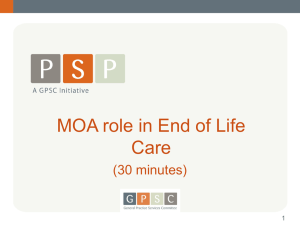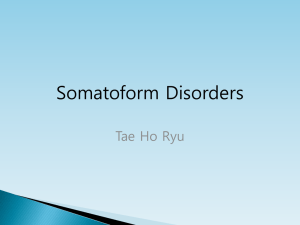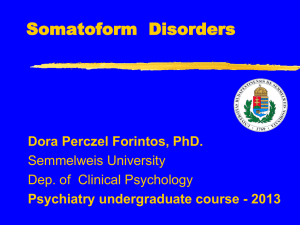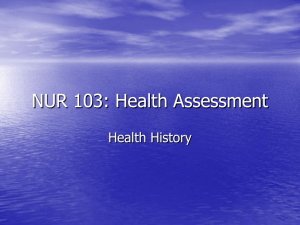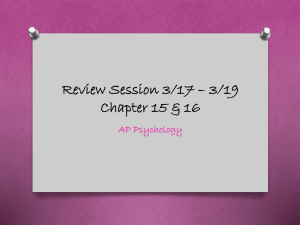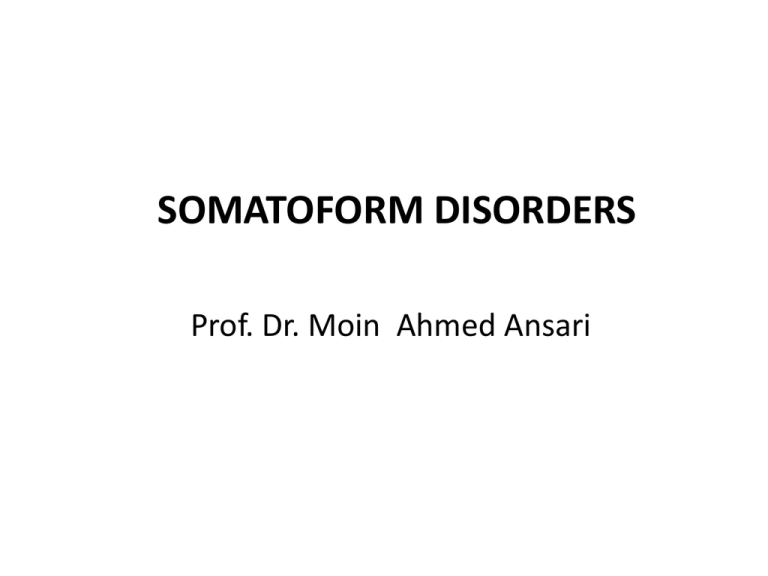
SOMATOFORM DISORDERS
Prof. Dr. Moin Ahmed Ansari
Somatization
Physical symptoms that are:
• unexplained after medical/physical examination
(i.e., medically unexplained symptom).
• Without organic pathology
• That are grossly in excess of what would be
expected from the physical findings
• associated with significant concern, distress or
impairment
• as a manifestation of psychological distress.
Somatizing patients:
Are unable to use emotional language to
describe their distress
Express their psychological illness or social
distress with somatic symptoms
Somatization is an entirely unconscious process
Mechanisms of Somatization
four theoretical perspectives
Neurobiological
Psychodynamic
Behavioral
Sociocultural
Neurobiological
Somatization results from defective or deficient
neurobiological processing of sensory and
emotional information
Psychodynamic
Somatized physiological sensations occur as
expressions of underlying emotional conflict
Somatization enables patients to meet latent
needs for nurturing and support
Behavioral
Somatization is viewed as behavior that is
brought about and reinforced by others in the
patient’s environment
“Illness-maintenance systems”
Sociocultural
Social norms concerning emotions
When a culture does not allow direct
communication of emotional content, one
means available to express emotions is through
physical symptoms
Somatization serves to notify others of
emotional or psychological distress in an
acceptable or non-stigmatized manner
Contributing Factors for
Somatization
Childhood abuse
Acute stress
Societal roles
Learned behavior
Secondary gain
Cultural factors
Histrionic, narcissistic, and borderline
personality traits
Symptoms
Vomiting
Nausea
Diarrhoea
Back pain
Dysuria
Shortness of breath
Chest pain
Amnesia
Visual changes
Sexual apathy
Impotence
Irregular menstruation
Deafness
Lump in the throat
Abdominal pain
Bloating
Pain in arms and legs
Joint pain
Headaches
Palpitations
Dizziness
Difficulty in swallowing
Paralysis/muscle weakness
Dyspareunia
Dysmenorrhoea
Menorrhagia
Seizures
Loss of voice
Somatization Disorder
(Briquet’s Syndrome)
• Multiple recurrent physical complaints over many
years
• No organic etiology for these complaints
• Begins by age 30
• Pain, GI, sexual, pseudoneurologic symptoms:
impaired coordination or balance, paralysis or
localized weakness, difficulty swallowing, aphonia,
urinary retention, hallucinations, loss of touch or
pain sensation,double vision, amnesia, sensory
losses, loss of consciousness
Frequently consult with many different doctors
seeking treatment, often with vague,
inconsistent and disorganised medial histories.
Has impaired social/work/personal functioning
Symptoms may be exacerbated by stress
No element of feigning symptoms to occupy sick
role (Facititious Disorder) or for material gain
(Malingerer)
Diagnostic Criteria
A history of many physical complaints beginning before
age 30 years that occur
over a period of several years and result in treatment
being sought or significant
impairment of functioning.
Each of the following criteria must have been met, with individual symptoms
occurring at any time during the course of the
disturbance.
o 4 pain symptoms: a history of pain related to at least
4 different sites or functions
o 2 gastrointestinal symptoms: a history of at least 2
gastrointestinal symptoms
other than pain
o 1 sexual symptom: a history of at least 1 sexual or
reproductive symptom other
than pain
o 1 pseudoneurological symptom: a history of at least 1
symptom or deficit
suggesting a neurological condition not limited to pain
Either: o After appropriate investigation, each of the
symptoms cannot be fully
explained by a known general medical condition or the
direct effects of a
substance OR
o When there is a related general medical condition,
the physical complaints or
resulting social or occupational impairment are in
excess of what would be
expected from the history, physical examination, or
laboratory findings
The symptoms are not intentionally produced or feigned.
Conversion Disorder
Conversion disorder is a mental health condition
in which a person has blindness, paralysis, or
other nervous system (neurologic) symptoms
that cannot be explained by medical evaluation.
Symptoms of a conversion disorder include the loss of
one or more bodily functions, such as:
Blindness
Inability to speak
Numbness
Paralysis
Common signs of conversion disorder include:
A debilitating symptom that begins suddenly
History of a psychological problem that gets better
after the symptom appears
Lack of concern that usually occurs with a severe
symptom
1 or more symptoms or deficits affecting voluntary
motor or sensory function that suggest a neurological
or other general medical condition
Psychosocial factors are judged to be associated with the symptom or deficit because the initiation or
exacerbation of the symptom or deficit is preceded by
conflicts or other stressors
The symptom or deficit is not intentionally produced or feigned.
The symptom or deficit cannot, after appropriate
investigation, be fully explained by a known general
medical condition or the direct effects of a substance,
or as a culturally sanctioned behavior or experience.
The symptom or deficit causes clinically significant distress or impairment in functioning, or warrants
medical evaluation
The symptom or deficit is not limited to pain or sexual dysfunction, does not occur during the course of
Somatization Disorder, and is not better accounted for
by another medical disorder.
Hypochondriasis
is an overwhelming fear that you have a serious
disease, even though health care providers can
find no evidence of illness. People with
hypochondriasis misinterpret normal body
sensations as signs of serious illness. This fear is
severe and persistent, and interferes with work,
as well as relationship.
Hypochondriasis
• Criteria:
– Persistent belief in the presence of one or more
serious illness underlying a presenting symptoms
– Unable to accept reassurance from multiple
doctors that there is no physical illness
– Persistent for more than 6 months
– Causing significant impairment/distress
– Not delusional in intensity
Hypochondriasis
•
•
•
•
•
•
•
Prevalence of 4.2-13.8% in general medical clinics
Equal prevalence amongst men and women
No increasing prevalence with age
No geographical factors
No evidence of genetic factors
Maladaptive behaviour can contribute
May be associated with childhood experiences
(chronic/serious illness in pt or family members/missing
school/traumatic experiences)
• May be associated with parental characteristics i.e.
overprotectiveness
• Chronic stable condition
Hypochondriasis
• Despite being a stable chronic condition, there
is an increased morbidity associated with it:
– risks of complications from investigations (3 times
more likely to be referred for further investigation)
– side-effects from inappropriate treatments
Body Dysmorphic Disorder
BDD is a body-image disorder characterized by
persistent and intrusive preoccupations with an
imagined or slight defect in one's appearance.
People with BDD can dislike any part of their
body, although they often find fault with their
hair, skin, nose, chest, or stomach. In reality, a
perceived defect may be only a slight
imperfection or nonexistent. But for someone
with BDD, the flaw is significant and prominent,
often causing severe emotional distress and
difficulties in daily functioning
Diagnostic Criteria
A. Preoccupation with an imagined defect in
appearance. If a slight physical anomaly is
present, the person’s concern is markedly
excessive.
B. The preoccupation causes clinically significant
distress or impairment in social, occupational, or
other important areas of functioning.
C. The preoccupation is not better accounted for
by another mental disorder (e.g., dissatisfaction
with body shape and size in Anorexia Nervosa).
Somatoform Pain Disorder
Somatoform pain disorder is pain that is severe
enough to disrupt a person's everyday life.
The pain is like that of a physical disorder, but no
physical cause is found. The pain is thought to
be due to psychological problems.
The pain that people with this disorder feel is
real. It is not created or faked on purpose
(malingering).
Diagnostic Criteria
Pain in one or more anatomical sites is the predominant
focus of the clinical presentation and is of sufficient severity
to warrant clinical attention.
The pain causes clinically significant distress or impairment
in social, occupational, or other important areas of
functioning.
Psychological factors are judged to have an important role
in the onset, severity, exacerbation, or maintenance of the
pain.
The symptom or deficit is not intentionally produced or
feigned (as in Factitious Disorder or Malingering ).
The pain is not better accounted for by a Mood, Anxiety, or
Psychotic Disorder.
Management
• Explain to the patient and family relationship
between psych and somatic
• Empathic attitude
• Avoid unnecessary investigation
• Treat underlying depression and anxiety
• Symptom variation provides teaching moments.
• “Goal of treatment is to figure out how you can
control symptoms.”
• Describe the potential for stress to affect
symptoms.
– Normal stress reaction in terms of sympathetic
arousal—the body’s “emergency mode.”
– For example, digestive functions are “turned off”
when stressed. If prolonged, results in digestive
distress (e.g., pain, constipation, diarrhea).
Behavioral Techniques
• Increased Activity Involvement
– Combats stress (minimize functioning in emergency
mode)
– Improves overall mood (as we see in dep treatment)
– Provides Distraction from somatic symptoms
– Pain perception has a subjective component—
improved mood and distraction reduce the experience
of pain
– Exercise has physiological effects that combat
somatization and stress
• Do they get their daily dose of meaningful
activity, productivity, and exercise?
Relaxation Techniques
• Directly acts on physical symptoms, given its effects on
breathing, heart rate, muscle tension, etc.
• Patients report benefit soon upon learning the
technique
• Helps with stress management
• Includes Diaphragmatic Breathing, Progressive Muscle
Relaxation, Biofeedback
– Practiced in session with patient, consecutively for a period
of weeks (combined with practice at home).
Sleep Strategies
– Establish consistent sleep patterns (same bedtime and
waketime everyday)
– Go to bed only when sleepy (stimulus control)
– If not asleep within 20-30 minutes leave bed and return
when sleep again (stimulus control)
– Bed is only for sleep and sex. No TV, reading, etc.
(stimulus control)
– Comfortable sleep environment
– Avoid alcohol/caffeine during 6 hours before bedtime
– Exercise regularly, but not within 4 hours of bedtime
Woolfolk and Allen (2007)
Cognitive Strategies
• Much like CBT for depression
– Looking for adaptability of thoughts
– Eliminating distortions
• Use somatic symptoms as anchors for examining
thoughts
• Look for variations in adaptability of thoughts and
discuss their effect
• Patients are likely to have difficulty identifying
thoughts/emotions.
• Likely to have schemas that include health concern
Pharmacological
No specific medicine
Treat concomitant psychiatric problem
Deal with dominant symptom:
Pain --Amitriptyline
Fatigue-- Bupropion
Anxiety, sleep dist --SSRI, TCA
Thank you for Patient Listening

